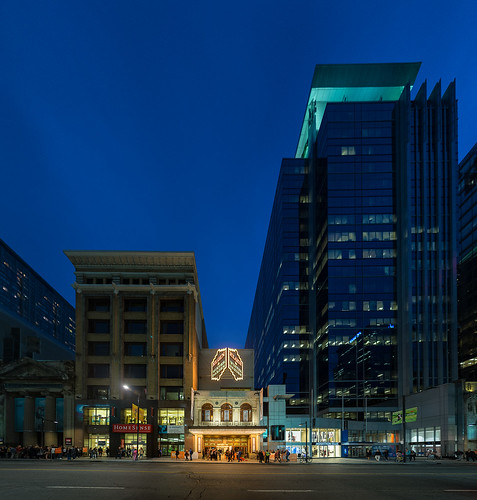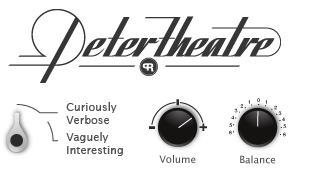Old Growth
What is it about these low-rise brick buildings that is so appealing?
Walking to work is like being in a slow tracking shot of the city. It gives you time to think and notice things. One thing I noticed was the inhumanity of some large older apartment blocks. I thought: did the people who designed these things hate people? Did they not understand people? Did they not “get” people? Why would you want to encase people in steel, entomb them in concrete or imprison people in what is supposed to be their home?

This is the type of photo I would classify as, Toronto not looking like Toronto.
Walking through St. Lawrence Market* I wondered why these older more ornate buildings were so much more appealing and comfortable? I don’t even like old things. I’m certainly no fan of antiques and old furniture and the fussiness of ornamentation. I’m a fan of contemporary and Modernist architecture, furniture and design. What I realized was I’m not a fan of the scale. It’s the inhuman scale of those ugly apartment buildings that makes them so unappealing. And not just the inhuman scale of the overall envelope but that everything is out of proportion. This is what I don’t like in Brutalist Architecture of a certain period too. Columns are too big, setbacks are too small, railings are too heavy and high and windows are like tiny archer slots or just cheap little vinyl or aluminum frames. Which is generally a problem I find with Toronto. We jumped from four to ten story buildings to 20,30 and now 70 storey buildings with nothing in between. It’s one of the main criticisms of Le Corbusier’s version of modernity. He got the scale all wrong. The taller a building is, the more space it needs around it, so it doesn't feel like it’s falling down on you, but the more space you add around it, the less humane, the more isolating the space becomes and the less like a community that space feels. Yet, proportions and ratios are what someone like Mies van der Rohe got so right and while the TD Towers may be considered stark and austere, they feel still feel comfortable and even inviting. The scale of the older city is appealing because the buildings and sidewalks and streets all feel proportionately right.

In general I kind of feel that way about modernity. We excel at scaling so much we grow well beyond what we are even prepared for. This obsession with growth and the certainty that growth is good is crushing us. Cities grow faster than their own infrastructure can handle. The pattern is obvious in Toronto. We build massive residential buildings and neglect to add any public space despite the private space in these buildings being minimized. Then we don’t add schools or grocery stores or coffee shops or any additional public transit or parking or road space or pedestrian space (in fact the sidewalks seem to get smaller). Worse yet we don’t add any additional electrical capacity, or storm sewer runoff even as we remove ways for water to be absorbed by the ground. Even sewage and waste capabilities can not keep up with the number of people added to that square kilometre of the city. Every smaller (read: older) apartment building you pass has additional dumpsters parked at the side of the building because apparently we produce that much more waste than when these places were built 40 years ago. Walk by the loading bay of a new condo tower and if the garage doors are open, you will be treated to an overwhelming stench of its immense garbage room. A 30-story tower makes enough garbage to make another 30-story pile of waste really quickly.
Typical juxtaposition of our inhumanly engineered infrastructure and that little bit of nature that wants to take the space back.
The ability to scale residential units outpaced our capacity to handle the scale we built. Yet rather than add scale at an appropriate rate we could keep up with, we demand people accommodate to the reduced capacity. There isn’t enough transit? We’ll take bikes, walk or worse yet, we’ll drive. Not enough parking for these new cars? We’ll pay more for parking making it reasonable to build entire structures to house unused vehicles - hey, in fact we’ll make those structures so big, parking will be cheap and affordable so more people can have cars. Are spring rainfalls causing flooding due to over stressed sewer systems? Simply buy more insurance or come up with new ways to pump water somewhere else. Not enough schools or shops nearby? That’s okay, we have cars remember? We’ll just drive there.
This idea of the inevitability of growth is also a problem for economies. It’s such a doctrine that any slowing of growth is a huge problem for established economies of the developed world. When growth slows it means we aren’t keeping up. There’s even a portmanteau term for it - “slowth” - when slowing growth indicates decline. Only technological advances offer opportunities for renewed growth. Like in the first and second industrial revolutions. Advances in telecommunications such as the Internet or mobile phones are another example. When a new technology comes along it may upend an established industry but replaces only some of those lost jobs with new ones because technology allows industry to scale up with fewer people. Those that lose out when their industry has been binned are just history’s losers.
It’s almost impossible to argue against “growth” but why does this piling-on-effect happen? Large cities like Toronto, London, Los Angeles or New York keep getting denser and more intense while draining people and resources from smaller cities. Instead of doubling development in Toronto, why aren’t we seeing added density in places like Hamilton or Kitchener-Waterloo where there is room for growth? Rather than rush to create false efficiencies, why not look elsewhere where there is need for growth. I say false efficiencies because growing density generates more waste than benefits that is seemingly overlooked. I guess this is one of those mysteries to living in a city and coming to terms with its own strange organic nature. Cities rise, reach saturation then something happens that changes everything and a place keeps thriving like London or contracts like Detroit. I guess if you could see what that “something” is, you’d be pretty clever. I’m not that clever. We’ve had enough of old growth and maybe it’s time for some new growth.
*I’m not sure if this area is St. Lawrence Market or Old Town. I’m pretty sure the term “Old Town” is just a marketing term for the part of the downtown core in the area of the St. Lawrence Market because I never see it used anywhere. Despite the trend of re-naming discrete blocks of the city for selling real estate at least Toronto hasn’t become like New York by creating meaningless nicknames of streets like “South of King” = “SoKi”. The newest area to have been developed is the West Don Lands, an abandoned and polluted former industrial site redeveloped as part of the Pan Am Games and has been given the moniker The Canary District which takes the name from a famously crusty old diner on the site and the fact that it neighbours the Gooderham and Worts Distillery site now known as the Distillery District.
Labels: architecture, design, landscape, Toronto


0 Comments:
Post a Comment
<< Home